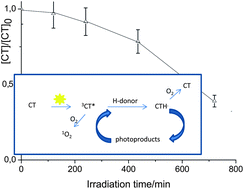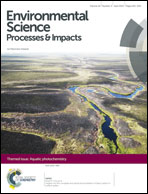Photoreactivity of the fungicide chlorothalonil in aqueous medium†
Abstract
The photoreactivity of chlorothalonil was studied by means of steady-state irradiation and laser-flash photolysis. Experiments were conducted in water containing acetonitrile as a co-solvent. This fungicide undergoes very slow phototransformation in the first stages of the reaction, but the consumption profile is auto-accelerated. To understand the reaction mechanism, we undertook a detailed study of the rates, products and transient species. The rates and photoproduct distribution vary greatly with the oxygen concentration. Concerning the transient species, we measured the absorption of the triplet, its yield of formation, and its reactivity with oxygen in various water–acetonitrile mixtures and with isopropanol. The reduced radical, CTH˙, could be produced and its transient spectrum was recorded. Combining all the experimental data, it is hypothesized that in the first step of the reaction CT is excited to the triplet state. The triplet has several possible fates including reduction by organic constituents to form the radical which gives photoproducts. Another characteristic of the CT triplet is its capacity to generate singlet oxygen. The production of this species was measured by phosphorescence and compared to the percentage of the triplet trapped by oxygen in air-saturated solutions. The yield varies from 0.88 in pure acetonitrile to 0.48 in water–acetonitrile (95 : 5, v/v). Therefore, in surface waters, chlorothalonil is expected to sensitize the photooxidation of micropollutants, and to be competitively phototransformed through reaction with any H donor or electron donor water constituents.

- This article is part of the themed collection: Aquatic photochemistry

 Please wait while we load your content...
Please wait while we load your content...